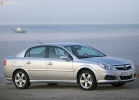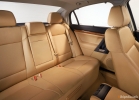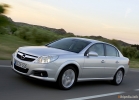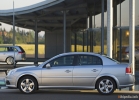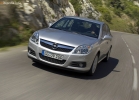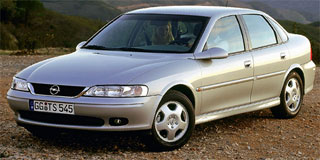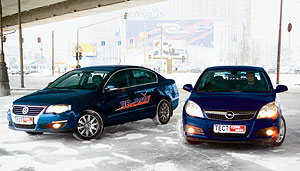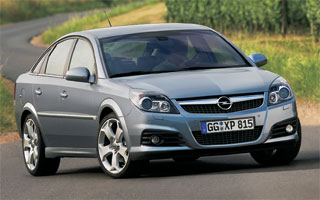Test Drive Opel Vectra Sedan 2005 - 2008 Sedan
Golden mean
Mazda6 or Opel Vectra: Select the middle class sedanWhat dreams of a potential owner of a family car (segment D on European classification)? Right about the miracle. And he sees it a miracle of a sedan with appearance with an appearance, the salon is a good, the trunk is more convenient, the engine is more powerful, a complete set of grace, and say the origin of the controversial about, German or Japanese. Well, the main thing is that the price is available. Miracles, of course, does not happen, but, permissible a well-known compromise, reconcile the desires with opportunities, find the belly car quite real. Verious evidence of today's characters of our heading.
In fact, both German and Japanese models are available in different bodies: In addition to the sedan, universals and hatchback are offered. The choice of engines is not too wide. Mazda line open 1,8-liter units with a capacity of 120 hp More powerful sixs are equipped with 2-liter 141-strong motors, and under the hood of the charged version of the 2.3-liter engine, which develops 166 forces. Vectra sedans and universals can be purchased with motors 1.6 (100 hp), 1.8 (122 hp) and 2.2 (147 hp), and the hot hatchback of Vectra GTS is available from 3 2-liter 211-strong units. With the choice of transmissions is even easier, especially by Mazda6 buyers. People who prefer machines with a machine gun, will have to take a 2-liter version. (Honestly, suspicious for the Japanese manufacturer dislike for the machine and subscribed us to take exactly such a car for the test, respectively, appointing Vectra 2.2 AT rivals to the rivals.
Exterior Vectra The embodiment of German solidity and thoroughness. Massive front bumper, large, almost square headlights, steep hood. In the appearance of the machine there was no hint of the grace, to a certain extent, the characteristic model of the previous generation. However, maybe it's right? In the end, VW Passat did not shine a bright individuality, but sales did not reduce this circumstance. Rather, on the contrary.
Six from Mazda looks completely different. The appearance dominates ease and swiftness. The feeling of dynamicity is created by a drop-down windows, a wedge-shaped hood and a rather large front skelet.
In the design of the front, an expressive falseradiator pentagon dominates. Rear view attract elegant lights.
The same sports attitude is also felt in the interior: a three-spoke steering wheel, skin-sheathed, central console and armrest linings are finished under aluminum. Climate control data, audio and trip-computer readings are displayed at the narrow information display at the top of the center console. Making the weather of special work is not: management of the main functions of the climate system is entrusted with three round handles, which rotate only the outer rings, and in the middle an additional buttons. Manipulating this simple set, the driver easily selects the necessary temperature and the mode of blowing, practically without breaking away from the road. It will not cause difficulties and communication with the audio system (judging by the number and purpose of the control buttons), which combines the tuner, the CD receiver and a cassette deck (in fact, only radio was present in the car, and the holes for the disk and the compact cassette were covered with plugs).
The driver's seat is quite spacious, and the range of seat controls and the steering column make it possible to take the optimal position to the person of almost any growth and the complex. The shape of the chair is almost flawless, except that the pushing back slightly stripped. Yes, the handle, head of the lumbar backup, the designers are not quite successful on the left side of the back, and grip it in a narrow slot between the seat and the central pillar of the body is frankly inconvenient.
Overall, the driver of the Vectra driver is well organized. It was not possible to settle behind the squeezed four-spoke branch of the skin. The benefit of the seat moves in all possible directions, and the range of adjustments is rather big. True, the profile of the chair is not accustomed (as well as on Mazda, it rather pushes the driver than it takes into an embrace, and the adjustment of the lumbric back is also located as uncomfortable). Yes, and some other design solutions look from the point of view of ergonomics, frankly say, controversial. Take, for example, stealless electron-mechanical type switches, in theory, designed to facilitate the life of the driver. Let's say, during rebuildings, there is a sufficiently easy touch to the left lever and the turning pointers will flash three times and go out. A stronger pressing of the lever is fixed, and turn signals work until the roaring returns to the zero position. In theory, everything is fine, but in practice, the line between the intermittent and constant modes is so blurry that it is not easy to dose on the lever correctly. You want to blink once, and the turn signal turned on the us. Trying to turn it off the reverse movement of the lever turns on the other side.
But if the driver will eventually get used to an unusual algorithm for the work of stealless switches, then comprehending the subtleties of climate control control requires a more thoughtful approach. At first glance, everything is traditionally three rotating handles: the extreme temperature control is administered, the average fan speed. But how to change the direction of streams, turn on the air conditioner? It turns out that you need to click on the middle round, after which the settings menu will appear on the liquid crystal display. Choosing the desired function, the driver activates it by repeatedly pressing the average handle. Then you need to exit the menu. In total, there are eight movements instead of one, and all of them are accompanied by a long visual control!
Now let's see what rear passengers can count on. In principle, cars are five-sends, but in reality only two can be settled in reality (which, however, the usual thing). Well, at least for the lack of place for the legs to complain not. In Mazda, the distance to the backs of the front seats is even somewhat larger than in Vectra, though, in the shoulders are still closer. It is curious that the tunnel in the floor does not look too cumbersome, although the Japanese car was developed with an eye on the all-wheel drive version. There are enough spaces over their heads in both sedans, even people growing. Finally, a couple of words about useful trifles available to passengers. In the Mazda salon, their list is exhausted by an ashtray and a pair of cup holders integrated into the folding armrest. Rear seat Opel looks hospitable. In addition to the 12-volt sockets and a clothing compartment in the armrest (coasters are stubcounted in the airbag), and the test vehicle is equipped with optional sunscreen curtains.
The trunks of both cars are large and comfortable, and the differences in size do not exceed several centimeters. And the seats are unfolded the same: the pillows are fastened tightly, and the backs are folded forward in parts. True, Mazda has one advantageous advantage: the backs can be thrown back by pulling the handle hidden in the side walls. Although if it comes to transportation of long-term (let's say, skis), the German sedan is probably preferable. After throwing back the armrest hiding in the back of the rear sofa, the owner will find a neat hatch, which allows partially to put a favorite sports projectile to the salon, without killing from there one of the passengers, as it would have to make the owner of Mazda.
However, it's time to go to the main ride quality of cars. The modern 5-speed automatic transmission Active Select provides an OPEL decent accelerating dynamics. From the site of Vectra River very actively. However, winter is not the best time for sharp starts with slipping: wheels and so dropping more often than I would like. Therefore, the winter regime in the transmission that makes the car smoothly touch from the second transfer, it was quite by the way. True, if necessary, it is not enough to sharply accelerate in motion in motion. The situation can be corrected by taking control of the box on yourself, but only partly: the alert electronics simply will not allow you to go to the too low in relation to the engine turnover. On the other hand, the protection against the fool here is some kind of one-sided: twisting the motor into the ringing and turning from the stage to the step on the fauce, the driver Vectra risks the bottom of the tachometer arrow in the red zone. The electronic cutoff is slightly late.
Against the background of the advanced transmission Opel, a simple four-stage MAZDA machine, it would seem to be saved. However, delays that felt when trying to actively accelerate small revolutions were surprisingly small.
And the change of gear happened smoothly, almost without jolts, as if by car with a stepless variator. In addition to the DRIVE mode, the selector can be translated in two Sport and Low driving positions. The first blocks the fourth transmission, the second allows the box to use only two first steps (of course, it is better not to use this mode for active ride).
At high-speed direct competitors behave equally well. Most likely this is a security steering with an electro-hydraulic amplifier, changing the characteristics, depending on the speed of movement: the higher, the more tangible gravity the ram is poured (however, the Mazda steering wheel is not particularly easily ease even in parking mode).
In general, the controllability of Mazda should be recognized as good. The car confidently keeps the road at high speed, easily comes in turns, quite grabs and the informativeness of the steering. However, provoking an active ride, the car requires the owner of adequate driving skills: say, with fast rebuildings there is a light back aback, and the steering is losing the informativeness reactive action falls, the driver remains to rely only on its vestibular device. The reserve of course stability and intense turns are not felt. If you lose the gas, the rear wheels will immediately turn into a slip, but quickly pull out the car (especially with the machine) is not always possible. It remains to actively work the ram. True, there is one substantial one: all these troubles take the driver only when the DSC stabilization system is turned off in an active state, smart electronics will instantly come to the rescue. Therefore, we would not advise you to release the electronic guardian angel at the wheel of Mazda6.
There is a similar system (with an unconnected) and on Vectra. However, in the actions of the driver, she interferes not so unceremoniously, providing a great degree of freedom while driving. It can be said that the electronics not so much prevents the loss of course stability, how much helps the steering quickly return to the course. In general, I will not say that the Japanese sedan is badly ruling, but Opel, in our opinion, listens to the driver a little better.
There were no issues to brake systems of competitors. Equipped with powerful disk mechanisms on all wheels and ABS, both cars slow down perfectly, without requiring correction even on a snow-covered road. Mazda pedal at first seems too responsive, but you quickly get used to it, it becomes easier to dose the effort.
And how are things going with driving comfort? He is far from perfect on both machines. Vectra suspension (Front McPherson with levers, fixed on a subframe, and a cross-stability stabilizer, from behind four-dimensional independent) differ slightly more compared to Japanese competitor energy intensity. Apparently, thanks to adaptation for Russian roads. Be that as it may, Opel reacts quite noticeably on the exemptions of the road cover.
However, in other situations, Mazda seems even more rigid. The fact is that the chassis developers were definitely given the priority of manageability and to the detriment of comfort and energy intensity used in the front suspension design of the double-to-step circuit. Super-compact multi-piece rear suspension (as well as the front, it is mounted on a powerful subframe) made it possible to significantly optimize the luggage compartment, but it turned out rather shortly, that the machine did not add comfort either.
Well, finally, let's talk about money. The level of basic configuration of Japanese cars is traditionally high. It did not exception and Mazda, offering an impressive list of factory equipment. Suffice it to say that the customer will ask only for an electrified hatch yes a leather salon (this will increase the base price of $ 26,500 by $ 400 and $ 800, respectively). Both options on our car were present. But there was an obvious gap in terms of optics: there was not only fashionable xenon, but even headlight washer and the front fog. In fairness, we note that xenon headlights with a washer in the standard package of test vectra performed by Elegance ($ 30,300) were also not included and appeared as an additional equipment ($ 975 and $ 200, respectively). But even basic halogens are equipped with a system of automatic correction of the light beam. There are enough other technical rims, such as an electronic CBC system controlling braking in turn.
The reader will find the list of recommended price manufacturers in the table. In our case, with relatively poor, or rather unstatable, equipping (neither your skin, nor Luke) The German sedan is more expensive than Japanese: for cars similar to those who visited the test, Mazda dealers and Opel are asked $ 27,800 and $ 32 210, respectively.
Text: Andrei Tsybulsky, Alexander Polunin
A source: McMobile magazine [01/31/2005]

